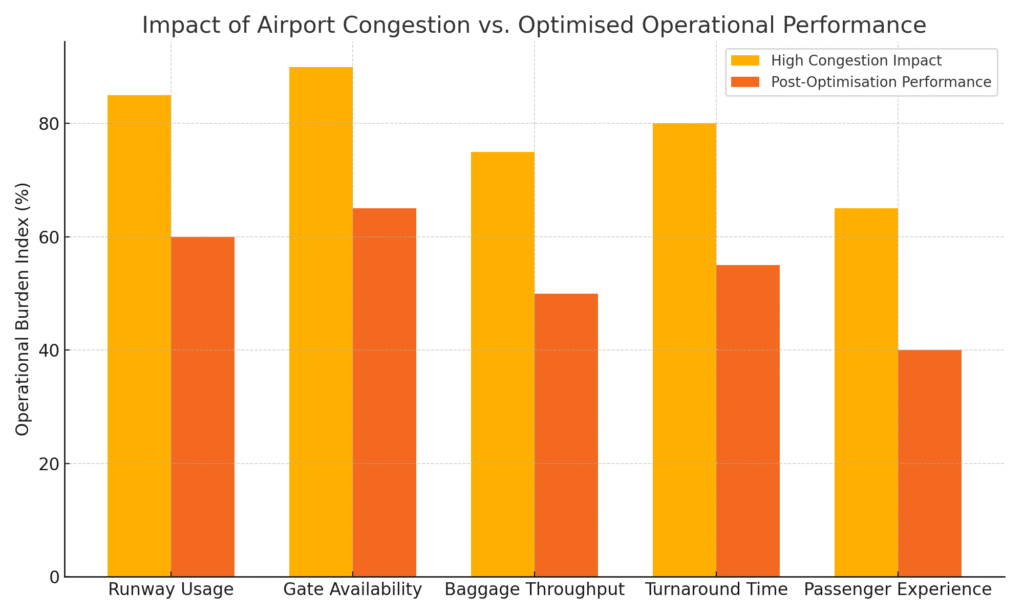Strategic Responses for Airlines and Airport Operators
Executive Summary
Airport congestion is no longer a peak-period inconvenience—it is a systemic challenge affecting airline schedules, passenger satisfaction, and operational costs. With air traffic volumes expected to double in the next 20 years, airlines and airport operators must act now. Pulse Infra offers strategic interventions—powered by data analytics, digital twin simulations, and process optimisation—that address the core constraints in ground operations. This whitepaper explores the root causes of congestion, successful mitigation strategies, and Pulse’s implementation framework for enabling smoother, more efficient airport operations.
Why Airport Congestion Matters More Than Ever
Global aviation has rebounded strongly post-pandemic, but the infrastructure hasn’t kept pace. Many major hubs operate at or beyond capacity, with ripple effects on airline reliability and customer experience. Delays cost the global airline industry over $30 billion annually, according to IATA. Congestion also affects gate availability, turnaround times, and airside logistics. Pulse Infra works with airports and carriers to reduce bottlenecks through system-wide visibility, smart scheduling, and integrated decision-making platforms.

Figure 1: Pulse Infra’s optimisation programs reduce operational burden across key airport congestion dimensions.
1. Where Congestion Hits Hardest
Pulse Infra’s diagnostics have identified five recurring pressure points:
– Runway saturation during peak banks
– Gate assignment conflicts and underutilisation
– Baggage processing delays
– Inefficient aircraft turnaround routines
– Fragmented data across airline and airport systems
Left unresolved, these issues not only increase operational costs but also degrade passenger experience—causing missed connections, delayed bags, and customer complaints.
2. Pulse Infra’s Playbook for Decongesting Airports
We apply a four-pillar strategy to enable airports and airlines to work smarter, not just harder:
1. **Digital Twin Modelling** – Simulate operational scenarios and test interventions before deployment
2. **Integrated Gate and Stand Optimisation** – Use AI to optimise real-time gate allocation
3. **Turnaround Time Analytics** – Identify variability drivers and standardise best-practice flows
4. **Joint Command Centres** – Create real-time operational dashboards shared across ground teams
3. Results in Practice: Pulse Infra Airport Case Studies
– In the Middle East, Pulse Infra helped a growing international hub reduce average aircraft turnaround by 19% through smart stand allocation and analytics-driven coordination with ground handlers.
– In Asia-Pacific, Pulse worked with a dual-runway airport facing peak congestion. By implementing dynamic runway slot balancing and predictive delay mapping, missed departure slots dropped by 24%.
– In Europe, Pulse Infra partnered with a regional carrier to co-develop a digital twin of its apron operations, helping plan for fleet expansion without expanding footprint.
4. Transforming Airside Efficiency Through Technology
Success in decongesting airports relies on:
– Data interoperability across A-CDM, airline, and baggage systems
– Real-time visibility of constraints and performance metrics
– Predictive analytics and early-warning alerts
– Workforce alignment and dynamic resourcing
Pulse Infra supports digital maturity assessments, capability uplift, and rollout of integrated operational dashboards that align airline, ground, and airport control teams.
Global Views on Airport Congestion
“Congestion isn’t solved by concrete—it’s solved by collaboration, visibility, and smart data decisions.”
– Jean-Luc Dubois, former COO, Aeroports de Paris
“Aviation recovery demands more than capacity upgrades. It demands rethinking ground operations with a data-first lens.”
– Noura Al-Fahad, Director of Smart Airports Program, GACA Saudi Arabia
Conclusion: Building Smarter, Not Bigger
Airport congestion can no longer be solved with infrastructure alone. Pulse Infra empowers stakeholders to build smarter systems—where digital tools, predictive insights, and aligned decision-making reduce pressure and enhance throughput. For airlines and airports committed to future-ready operations, this whitepaper is a call to rethink efficiency at the gate, not just in the air.
